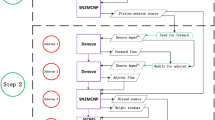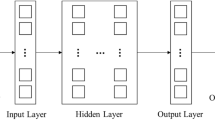Abstract
As temperature changes constantly in nuclear reactor operation, on-the-fly Doppler broadening methods are commonly adopted for generating nuclear cross sections at various temperatures in neutron transport simulation. Among the existing methods, the widely used SIGMA1 approach is inefficient because it involves error function and Taylor series expansion. In this paper, we present a new on-the-fly Doppler broadening with optimal double-exponential formula based on SuperMC to improve efficiency with given accuracy. In this method, double-exponential formula in 1/16 steps is used for broadening cross section at low energy, with both accuracy and efficiency. Meanwhile, the Gauss–Hermite quadrature of different orders is used for broadening cross section at resonance energy. The method can generate neutron cross section rapidly and precisely at the desired temperature. Typical nuclide cross sections and benchmarking tests are presented in detail.







Similar content being viewed by others
References
R. Macfarlane, D. Muir, R. Boicourt et al., The NJOY nuclear data processing system, version 2012, LA-UR-12-27079, Los Alamos National Laboratory (2012).
D. Cullen, PREPRO 2015: 2015 ENDF/B Pre-Processing Codes, IAEA-NDS-39, Rev. 14 International Atomic Energy Agency (2015).
D. Cullen, Program SIGMA1 (version 79-1): Doppler broaden evaluated cross sections in the evaluated nuclear data file/version B (ENDF/B) format, UCRL-50400, Lawrence Livermore National Laboratory (1979).
G. Yesilyurt, W. Martin, F. Brown, On-the-fly Doppler broadening for Monte Carlo codes. Nucl. Sci. Eng. 171, 239–257 (2012). doi:10.13182/NSE11-67
T. Viitanen, J. Leppanen, Explicit treatment of thermal motion in continuous-energy Monte Carlo tracking routines. Nucl. Sci. Eng. 171, 165–173 (2012). doi:10.13182/NSE11-36
B. Forget, S. Xu, K. Smith, Direct Doppler broadening in Monte Carlo simulations using the multipole representation. Ann. Nucl. Energy 64, 78–85 (2014). doi:10.1016/j.anucene.2013.09.043
A. Villanueva, J. Granada, Experimental evidence sustaining a compact-extended model for Doppler broadening of neutron absorption resonances. Ann. Nucl. Energy 38, 1389–1398 (2011). doi:10.1016/j.anucene.2011.01.034
P. Romano, T. Trumbull, Comparison of algorithms for Doppler broadening pointwise tabulated cross section. Ann. Nucl. Energy 75, 358–364 (2015). doi:10.1016/j.anucene.2014.08.046
C. Dean, R. Perry, R. Neal et al., Validation of run-time Doppler broadening in MONK with JEFF3.1. J. Korean Phys. Soc. 59, 1162–1165 (2011). doi:10.3938/jkps.59.1162
G. Ferran, W. Haeck, A new method for the Doppler broadening of the Solbrig’s kernel using a Fourier transforms. Nucl. Sci. Eng. 179, 1–17 (2015). doi:10.13182/NSE14-64
Y. Wu, J. Song, H. Zheng et al., CAD-based Monte Carlo program for integrated simulation of nuclear system SuperMC. Ann. Nucl. Energy 82, 161–168 (2015). doi:10.1016/j.anucene.2014.08.058
Y. Wu, F.D.S. Team, CAD-based interface programs for fusion neutron transport simulation. Fusion Eng. Des. 84, 1987–1992 (2009). doi:10.1016/j.fusengdes.2008.12.041
Y. Wu, Z. Chen, L. Hu et al., Identification of safety gaps for fusion demonstration reactors. Nat. Energy 1, 16154 (2016). doi:10.1038/nenergy.2016.154
Y. Wu, J. Jiang, M. Wang et al., A fusion-driven subcritical system concept based on viable technologies. Nucl. Fusion 51, 103036 (2011). doi:10.1088/0029-5515/51/10/103036
Y. Wu, F.D.S. Team, Design analysis of the China dual-functional lithium lead (DFLL) test blanket module in ITER. Fusion Eng. Des. 82, 1893–1903 (2007). doi:10.1016/j.fusengdes.2007.08.012
D. Cullen, C. Weisbin, Exact Doppler broadening of tabulated cross section. Nucl. Sci. Eng. 60, 199–229 (1976). doi:10.13182/NSE76-1
H. Takahasi, M. Mori, Double-exponential formulas for numerical integration. Publ. Res. I. Math. Sci. 9, 721–741 (1974)
M. Mori, M. Sugihara, The double-exponential transformation in numerical analysis. J. Comput. Appl. Math. 127, 287–296 (2001). doi:10.1016/S0377-0427(00)00501-X
J. Briggs, L. Scott, A. Nouri, The international criticality safety benchmark evaluation project. Nucl. Sci. Eng. 145, 1–10 (2003). doi:10.13182/NSE03-14
R. Mosteller, ENDF/B-V, ENDF/B-VI, ENDF/B-VII.0 Results for the Doppler-Defect Benchmark, LA-UR-07-0922, Los Alamos National Laboratory (2007).
Acknowledgements
The authors would like to show their great appreciation to other members of the FDS Team for supports to this research.
Author information
Authors and Affiliations
Corresponding author
Additional information
This work was supported by the Strategic Priority Science and Technology Program of the Chinese Academy of Sciences (No. XDA03040000), the Innovation Foundation of the Chinese Academy of Sciences (No. CXJJ-16Q231), the National Natural Science Foundation of China (NSFC) (Nos. 11305205, 11305203, 11405204 and 11605233), the National Magnetic Confinement Fusion Science Program of China (No. 2014GB112001), the Special Program for Informatization of the Chinese Academy of Sciences (No. XXH12504-1-09), the Anhui Provincial Special project for High Technology Industry, the Special Project of Youth Innovation Promotion Association of Chinese Academy of Sciences, the Industrialization Fund, the Open Funds of Engineering Research Center of Nuclear Technology Application of Ministry of Education (No. HJSJYB2011-11) and Jiang Xi young science foundation project (No.GJJ150558).
Rights and permissions
About this article
Cite this article
Chen, R., Hao, LJ., Wu, B. et al. On-the-fly Doppler broadening method based on optimal double-exponential formula. NUCL SCI TECH 28, 166 (2017). https://doi.org/10.1007/s41365-017-0318-4
Received:
Revised:
Accepted:
Published:
DOI: https://doi.org/10.1007/s41365-017-0318-4




